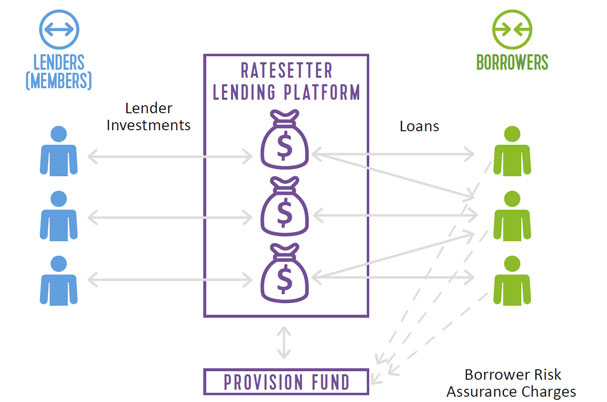Interesting article from Bloomberg Business on the continuing morphing of P2P lending into the main stream, and potentially wrapped up into derivatives.
It began with a seemingly wacky idea to reinvent banking as we know it. But no one is scoffing at peer-to-peer lending anymore — least of all, Wall Street. Barely a decade old, “P2P” has gone mainstream and is now being co-opted by some of the big financial players it was supposed to bypass. Investment funds can’t get enough of this business, which involves lending to people over the Internet and hoping they pay you back. Investors are snapping up the loans directly, while the banks are bundling them into securities, much as they did with subprime mortgages.
Now peer-to-peer lending and its Internet enablers like LendingClub Corp., the industry leader, are being pulled into the high-octane world of derivatives. While many hail Wall Street’s growing involvement, others warn investors could get carried away, as they did during the dot-com era and again during the mortgage mania. The new derivatives could help people hedge their risks, but they could also lure speculators into the market.
“It feels like the year 2000 again,” said Frank Rotman, a partner at QED Investors, an Alexandria, Virginia-based venture-capital firm that has invested in Prosper Marketplace Inc., Social Finance Inc. and 13 other P2P lending platforms. “Everyone is chasing ’it,’ but they don’t know what ’it’ is, and that is kind of scary.”
Lured by Yield
It’s easy to see why investors are so enthusiastic. In today’s low-interest-rate world, high-quality P2P loans yield about 7.6 percent. Two-year U.S. Treasuries, by comparison, were yielding a mere 0.6 percent on Friday.
But P2P’s rapid growth also raises questions about the potential risks, including whether the firms involved might lower their standards to stay competitive. During the mortgage boom, Wall Street’s securitization machine fueled questionable lending practices. Derivatives tied to the debt were blamed for spreading their risks around the globe, and then amplifying investors’ losses when the housing market crashed.
Now a firm led by Michael Edman, a veteran of Morgan Stanley, is creating derivatives that will give investors a new way to bet for — or against — peer-to-peer loan performance. Edman has ridden credit booms before: he was a figure in “The Big Short,” Michael Lewis’s best-seller about the buildup to the housing bubble of the 2000s.
“It’s a high-coupon asset that’s had very good returns for the short period of time it’s been around,” Edman said of P2P loans. “I don’t have reason to believe that’s going to change dramatically anytime soon, but there are bad loans out there.”
Satisfying Demand
Derivatives could help satisfy investors’ demand for P2P assets, while also helping others hedge risks on loans they’ve already bought. The instruments could also bring more investors swooping into the market simply to place speculative wagers.
Brendan Dickinson, principal at Canaan Partners, a $4.2 billion asset firm based in New York and Menlo Park, California, is counting on the former.
“If you could create a synthetic product that mimics all the features of a P2P loan and had the same risk and yield tradeoff, there would be a lot of demand to buy that paper,” said Dickinson, whose firm has invested in LendingClub and Orchard Platform and is looking to invest $5 million to $10 million in a firm trying to create derivatives on P2P loans. Other small firms are racing to create P2P derivatives before big banks try to muscle in.
Derivatives Pioneer
Edman, who runs New York-based Synthetic Lending Marketplace, or SLMX, has some high-profile experience. In the early 2000s, he helped invent a kind of credit-default swap that enabled some Wall Street firms to bet against U.S. subprime mortgage bonds.
But Edman sees little resemblance between the boom-era mortgage market of and the current peer-to-peer market. He said his derivatives will help investors hedge their bets and also improve the pricing of the underlying loans.
Indeed, Edman said the ability to short the loans could curb some of the enthusiasm for this asset class before any of the debt sours.
“If derivatives in mortgage-backed securities existed in 1998, we wouldn’t have gotten to the point that we did in terms of the bubble in mortgages,” Edman said. “This keeps a market honest.”
Investors are already showing some skepticism. Less than a year after going public, LendingClub is the sixth-most bet against stock on the New York Stock Exchange.
‘Legitimate Need’
LendingClub chief executive officer Renaud Laplanche said he’s aware of the interest to bet against the market. Derivatives that give investors the ability to protect against losses on the loans the company arranges is just smart risk-management, he said.
Spokeswomen for Prosper and Social Finance declined to comment.
SLMX is still working on documentation for the derivatives, which are likely to take the form of credit-linked notes with total-return swaps, rather than the credit-default swaps some blame for worsening the financial crisis. The firm has teamed up with a broker-dealer, AK Capital LLC, to execute trades and hopes to make its first transaction as early as this year.
Rotman said another firm, PeerIQ, has discussed with him the possibility of creating contracts that would essentially zero in on loans arranged by LendingClub, the industry leader, which has facilitated $7.6 billion of loans since 2006. PeerIQ – – whose financial backers include John Mack, the former CEO of Morgan Stanley and Vikram Pandit, the former CEO of Citigroup Inc. — hasn’t publicly disclosed any plans; a spokesman for the firm declined to comment. Those men recently led a $6 million investment round for the company’s analytics business.
LendingClub’s chief executive officer Laplanche called PeerIQ a third-party partner, no different than other companies seeking to utilize the company’s public data.
“It is a perfectly legitimate need from many of our investors, especially large ones,” Laplanche said.

